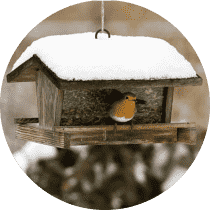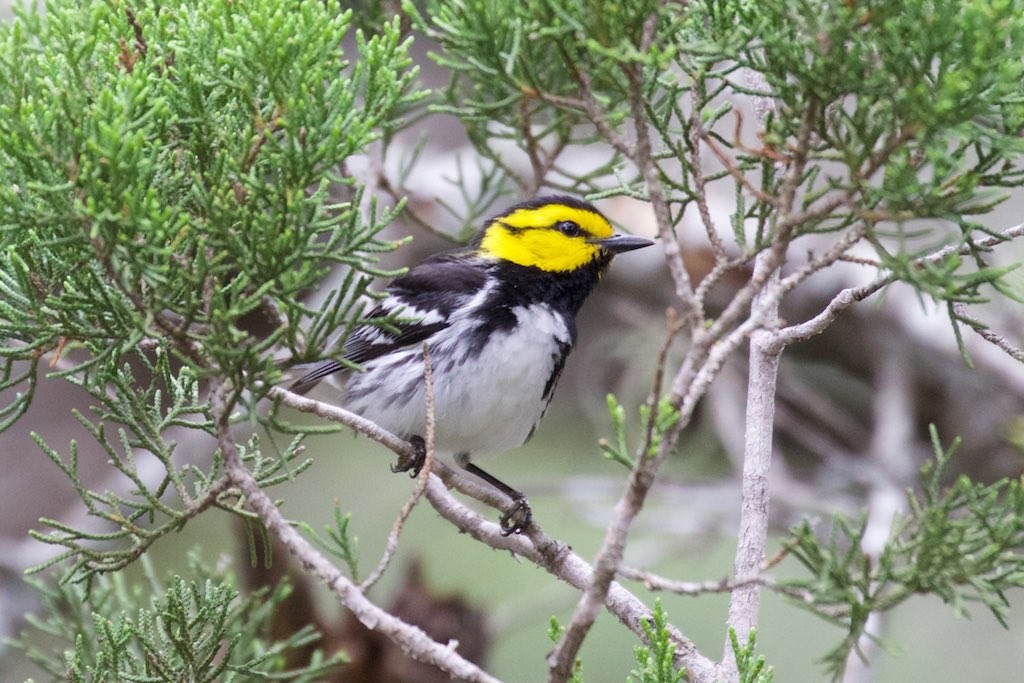Golden-cheeked Warbler
A species of Setophaga Warblers Scientific name : Setophaga chrysoparia Genus : Setophaga Warblers
Golden-cheeked Warbler, A species of Setophaga Warblers
Botanical name: Setophaga chrysoparia
Genus: Setophaga Warblers
Description
The golden-cheeked warbler (Setophaga chrysoparia [formerly Dendroica chrysoparia]), also known as the gold finch of Texas, is an endangered species of bird that breeds in Central Texas, from Palo Pinto County southwestward along the eastern and southern edge of the Edwards Plateau to Kinney County. The golden-cheeked warbler is the only bird species with a breeding range confined to Texas. 
Size
12-13 cm (4.75-5 in)
Colors
Black
Yellow
Gray
White
Life Expectancy
8 years
Nest Placement
Tree
Clutch Size
3 - 5 eggs
Incubation Period
1 - 2 broods
Number of Broods
10 - 12 days
Nestling Period
9 - 12 days
Feeding Habits
Golden-cheeked Warbler preys on soft-bodied insects and their larvae, such as caterpillars, plant lice, beetles, ants, and flies, as well as spiders. Golden-cheeked Warbler refines larger food by smashing against branches and typically forages by gleaning, hover-gleaning, or fly-catching, often in evergreens or oaks.
Habitat
The golden-cheeked Warbler's habitat is characterized by mature juniper-oak woodlands within the Texas Hill Country's limestone hills and canyons. Key vegetation includes Ashe juniper and various oak species, with a necessity for dense canopy cover and old-growth forests. Altitudes range from 590 to 1,700 feet. They may also inhabit less-vegetated woodlands and savannas. Migratory and winter habitats mirror breeding areas, extending to pine-oak and cloud forests in higher altitudes up to 8,300 feet.
Nest Behavior
Females choose the site, construct and defend the nest, predominantly in Ashe juniper or oaks. Construction peaks during the breeding season. Golden-cheeked Warbler lays eggs in the spring and provides parental care, with specifics on timing and patterns varying per individual or environmental factors.
Nest Characteristics
Golden-cheeked Warbler's nest is a cup-shaped construct woven from Ashe juniper bark, twigs, leaves, grass, oak leaves, lichen, seeds, rootlets, moss, spider cocoons, feathers, hair, and wool, bound by spider silk. Located 16–23 feet high, typically in tree forks, it measures 3.2 inches wide and 2 inches tall, with a 1.9-inch-wide, 1.5-inch-deep cavity.
Dite type
Insectivorous
People often ask
Migration Overview
Golden-cheeked Warblers will only remain in Texas for the breeding season, from March to June. They will migrate with other songbird species along Mexico's Sierra Madre Oriental. By the first week of March, the Warblers will return to Texas to breed. During the winter season (November–February), Warblers will travel to Guatemala, Nicaragua, Honduras, and Mexico. 
General Info
Feeding Habits
Bird food type
Bird Feeder Type

Small Hopper

Platform
Behavior
Golden-cheeked Warbler exhibit a blend of communal and territorial habits. They are noted for their early arrival on breeding grounds, with males staking claims over territories reaching 4 to 10 acres by singing from prominent positions. This territorial singing is a season-long endeavor to deter rivals. Golden-cheeked Warbler are less frequently observed in courtship, which involves a subtle display from males, including a gentler song and a show of wings and tail, while females gather nest materials. The pair collaborates in rearing their young, with both provisioning food, and are committed to their territory, rarely straying unless in search of water. Post-fledging, parenting duties may be divided, and golden-cheeked Warbler can integrate into mixed-species groups before their July to August migration.
Distribution Area
The Golden-cheeked Warbler can be found in numerous state parks within Texas. These parks include the “Colorado Bend State Park (SP), Dinosaur Valley SP, Garner SP, Guadalupe River SP, Honey Creek State Natural Area (SNA), Hill Country SNA, Kerr Management Area, Longhorn Cavern SNA, Lost Maples SNA, Meridian SP, Pedernales Falls SP, and Possum Kingdom SP.” The golden-cheeked warbler (GCWA) are endemic to Texas and no other quarters. Their habitat can range from moist, to dry areas around central and southern Texas. The nesting habitat in the further moist realms can be discovered in tall, closed canopy, compressed, mature stands of Ashe juniper trees along with Texas, shin, live, Lacey, and post oak trees. In the drier spheres of Texas the GCWAs can be found in upland juniper-oak woodlands off of flat topography. They use Ashe juniper bark and spider webs to build their nests. Females lay three to four eggs. When migration and winter hits the habitat stays relatively similar: a variety of short-lived evergreen forests with pines between 3,300 and 8,300 feet. 
Species Status
The breeding range of the warbler ranges to an extent of only about twenty acres, so spaces for habitation are limited. Many spots of warbler habitation have been cleared for the construction of houses, roads, and stores or to grow crops or grass for livestock. Juniper trees, the primary nesting place for warblers, have also been cut down and used for different timber products, especially before the 1940s. Other woodlands were flooded when large lakes were constructed. Sitting at the top of the endangered list (of species in North America) since May 1990, different projects are currently underway to restore the habitat of the Golden-Cheeked warbler. Efforts include The Safe Harbor agreement between Environmental Defense and the U.S. Fish and Wildlife Service, with the goal of rebuilding and creating new, safe habitats for the warbler (along with other endangered species). The Balcones Canyonlands Conservation Plan (BCCP) is another project responsible for building warbler preserves, with the goal of eventually adding a total of 41,000 acres to the warbler's habitat . These initiatives along with many others encourage landowners to learn more about the warbler (along with other species that inhabit their property) so local land owners may provide proper maintenance and protection of the warbler's habitat. A project that significantly aided habitat restoration for the Warbler includes the U.S. Army's success at Fort Hood in protecting the largest patch of juniper-oak trees. 
Scientific Classification
Phylum
Chordates Class
Birds Order
Perching birds Family
New world warblers Genus
Setophaga Warblers Species
Golden-cheeked Warbler 